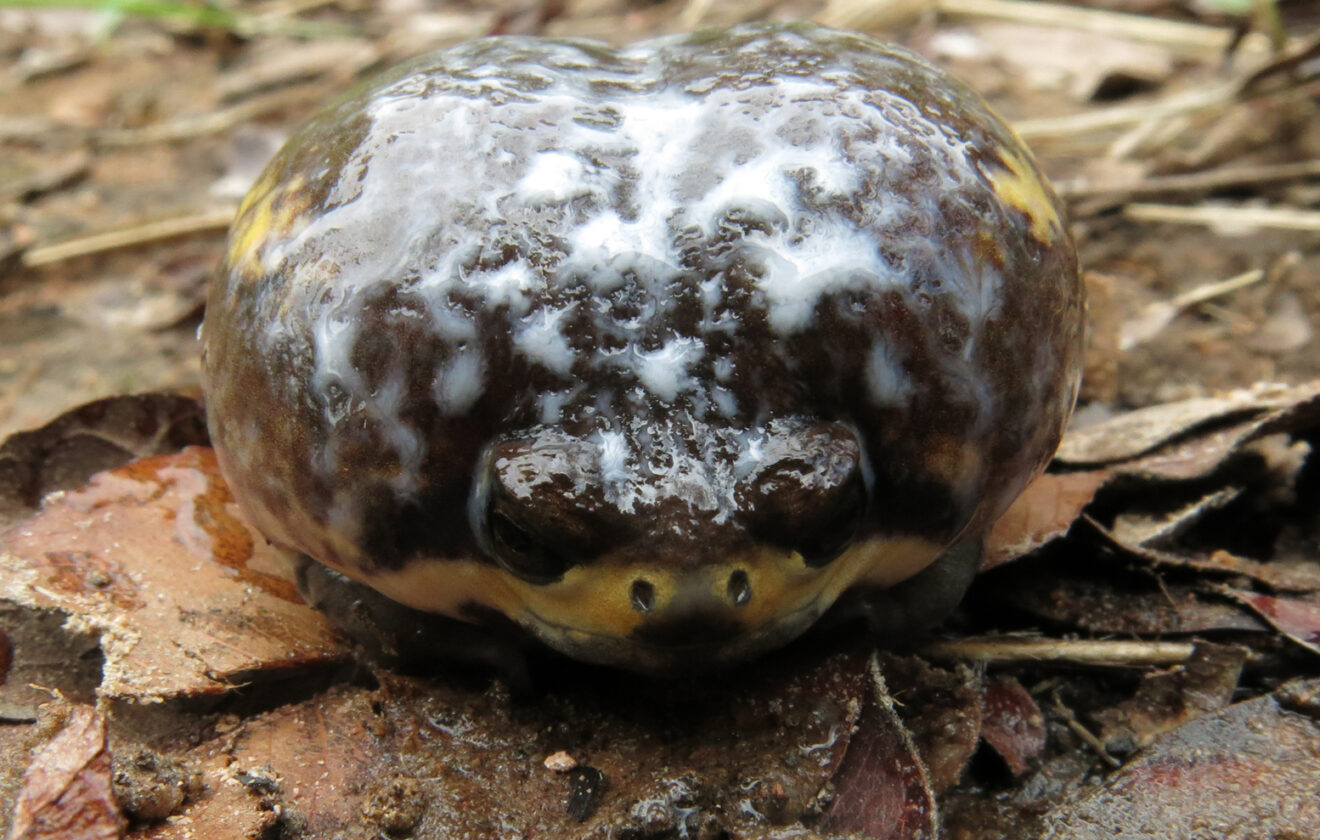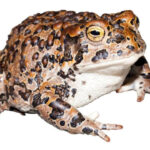- Unearthing the Secrets of Power's Rain Frog (Breviceps poweri): A Hidden Jewel of Africa's Forest Floors
- Taxonomy and Classification
- Natural Habitat and Geographic Distribution
- Physical Characteristics: Fashioned for the Forest Floor
- Behavior and Life Cycle: The Secret Lives Beneath the Leaves
- Ecological Role and Importance
- Threats and Conservation Status
- Cultural and Scientific Significance
- Conclusion: Protecting the Jewel of Africa's Forest Floors
Unearthing the Secrets of Power’s Rain Frog (Breviceps poweri): A Hidden Jewel of Africa’s Forest Floors#
Tucked amidst the damp leaf litter and shaded groves of Southern Africa’s woodlands exists an enigmatic amphibian of beguiling charm—Power’s rain frog, scientifically known as Breviceps poweri. With its rounded body, soulful eyes, and decidedly pugnacious appearance, Breviceps poweri might appear modest at first glance, yet its role in the ecosystem and the fascinating intricacies of its life history command attention and admiration. Indeed, there is far more to this peculiar frog than mere outward charm; hidden within its plump silhouette lies an incredible evolutionary story and a remarkable capacity for survival.
Named after the notable herpetologist John Hyacinth Power, who initially described this species in detail, Breviceps poweri is renowned not only for its captivating appearance but also for a set of unique behaviors and adaptations finely honed by millions of years of evolutionary craftsmanship. From their signature defensive postures to their distinctive reproductive strategies, Power’s rain frogs occupy a special niche in their ecological communities—a quiet yet vital participant in the complex tapestry of African biodiversity.
Journey with us now as we explore the rich details of this enthralling amphibian. Discover the secrets that underscore the significance of Power’s rain frog, and learn how the preservation of this tiny creature echoes far beyond its leafy home, resonating deeply with conservation efforts crucial to protecting our planet’s biological diversity.
Taxonomy and Classification#
In the diverse and sprawling world of amphibians, systematic classification is essential for understanding relationships and evolutionary histories. Power’s rain frog, scientifically titled Breviceps poweri, belongs to the fascinating family Brevicipitidae. This family is distinguished by its small but rotund-bodied frogs, which commonly inhabit subterranean and ground-level niches across parts of sub-Saharan Africa. Members are well-renowned for their highly rounded shape and burrowing lifestyles, adaptations ideally suited to earthly and arboreal locales alike.
The genus Breviceps itself comprises several related species, many of them displaying similar body shapes and habits. However, each species possesses subtle yet significant distinctions. In particular, Breviceps poweri stands apart from its cousins not only in geographical distribution but also in the finer details of its morphology, coloration, and behavioral profile. Closely allied species, such as Breviceps adspersus or Breviceps mossambicus, share habitats that somewhat overlap in distribution, yet Power’s rain frog maintains a distinct ecological and morphological identity.
Natural Habitat and Geographic Distribution#
Power’s rain frog inhabits a specific yet scattered range across southern Africa, predominantly found within countries such as Zimbabwe, Malawi, Zambia, Botswana, and Mozambique. Unlike typical amphibians, which favor aquatic environments or streams, Breviceps poweri exhibits a marked preference for terrestrial habitats, habituating mainly within subtropical or tropical lowland forests, savannas, and moist shrublands.
This small amphibian thrives in environments abundant with leaf litter, decomposing wood, and humid soil. Beneath the thick canopies and tangled understories of southern African woodlands, leaf-strewn floors provide not only camouflage but also a buffet of invertebrate prey—offering shelter and sustenance crucial to their survival. It is in these soft, nutrient-rich layers that Breviceps poweri digs shallow burrows and retreats, hidden from predators and the harshness of dry seasons alike.
An Expert Burrower and Ambush Predator#
The soil-bound existence of Power’s rain frog reflects an ancient evolutionary compromise, one that allows it to limit moisture loss and avoid larger predators. These amphibians rarely stray from cover, emerging primarily during damp weather, typically at night or during the rainy season when humidity saturates their habitat. During periods of drought or heat, they remain safely ensconced beneath layers of soil and vegetation, relying on their adeptness as diggers to burrow through sandy loam and maintain the moisture levels essential to their survival.
Physical Characteristics: Fashioned for the Forest Floor#
A close inspection of Breviceps poweri reveals the expert craftsmanship of evolution in reaction to its shadowed dwelling place. Typically growing to a modest 3 to 4 centimeters, this species is rounded and robust, appearing inflated and strikingly spherical, as though carved from clay by careful, gentle fingers. Their short, sturdy legs and broad, barely visible toes, equipped with toughened digging implements, showcase an undeniable specialization for life beneath the surface.
Coloration varies remarkably across their range, blending seamlessly with their environment. Typically, hues oscillate between mottled shades of brown, tan, and rust-red, often interspersed with darker markings or irregular blotches. This cryptic camouflage is not mere ornamentation; it provides exceptional concealment amongst shadows, leaf litter, and damp soil, rendering the animal all but invisible to casual observers and vigilant predators alike.
Unique Defensive Adaptations#
Power’s rain frog supplements camouflage with other adaptations that enhance survival prospects, particularly those striking defensive behaviors exhibited when encountering threats. When disturbed or handled, the startled frog inflates itself, puffing up to a larger size to both deter and confuse predators. This fascinating defensive reaction is often paired with a peculiar squeaking or chirping sound, loudly objecting to interference, startling predators into reconsidering their approach.
Behavior and Life Cycle: The Secret Lives Beneath the Leaves#
As primarily nocturnal and subterranean beings, Power’s rain frogs lead lives cloaked in secrecy, mostly unnoticed by the human gaze. However, dedicated study has illuminated the behaviors, strategies, and life-history characteristics of Breviceps poweri, allowing us an insightful glimpse into their hidden world.
Feeding Habits and Diet#
As ambush predators, Power’s rain frogs rely on stealth and patience, perched motionless beneath leaf carpets until prey—a variety of tiny insects and terrestrial invertebrates—come within reach. Their dietary strategy thrives thanks to finely-tuned senses, allowing them to detect movements and vibrations in the leaf litter, swiftly lunging to consume unsuspecting victims. Their powerful, extendable tongues facilitate rapid prey capture, making them efficient and formidable hunters at their diminutive scale.
Breeding and Reproductive Behavior#
Reproduction in Breviceps poweri involves intriguing adaptations reflective of their terrestrial habit. Unlike other frog species that depend on ponds, streams, or standing water bodies, these frogs breed and lay eggs underground or amongst leaf litter in moist locations. Female frogs lay small clutches of relatively large eggs, encased by jelly membranes to conserve moisture and protect from physical harm. Notably, these eggs hatch directly into miniature froglets, bypassing the aquatic tadpole stage completely—a remarkable evolutionary adaptation known as direct development.
Ecological Role and Importance#
Power’s rain frogs exert influence disproportionately significant relative to their modest size and secretive nature. Serving primarily as insectivores, Breviceps poweri assists control insect populations, maintaining balanced ecosystems. Concurrently, these frogs provide a valuable food resource for predators, including various birds, snakes, and small mammals—thereby anchoring vital ecological networks.
Moreover, as sensitive amphibians, they effectively function as ecological indicators, their existence—or decline—offering early warning signals of habitat degradation, environmental toxins, and microclimatic transformations.
Threats and Conservation Status#
Despite their ecological importance, Power’s rain frogs face considerable pressures in their native habitats. Habitat loss due to human activity—chiefly agriculture, deforestation, and urban expansion—poses a primary threat. Furthermore, climate change exacerbates drought conditions and alters rainfall patterns, potentially imperiling populations reliant on predictable moisture cycles.
Currently listed as Least Concern by the IUCN Red List, nonetheless careful monitoring is critical, as declines and population fluctuations remain poorly documented due primarily to their elusive lifestyles.
Cultural and Scientific Significance#
Beneath their modest exterior, Power’s rain frogs provide deeper insights into evolutionary biology, offering unparalleled opportunities for studying terrestrial adaptations, behavioral ecology, and amphibian diversification. Additionally, local communities occasionally recognize this frog for its distinctive vocalizations and peculiar behaviors, bestowing cultural novelty as storytellers imbue these amphibians with intriguing symbolic attributes in folklore and myth.
Conclusion: Protecting the Jewel of Africa’s Forest Floors#
Breviceps poweri encapsulates a testament to nature’s subtle yet magnificent craftsmanship. To safeguard this remarkable amphibian species, conservationists, decision-makers, and communities must unite, championing their preservation and respecting their habitats. Let the subtle yet captivating narrative of Power’s rain frog inspire a renewed commitment to preserving Earth’s intricate and delicate web of life.









